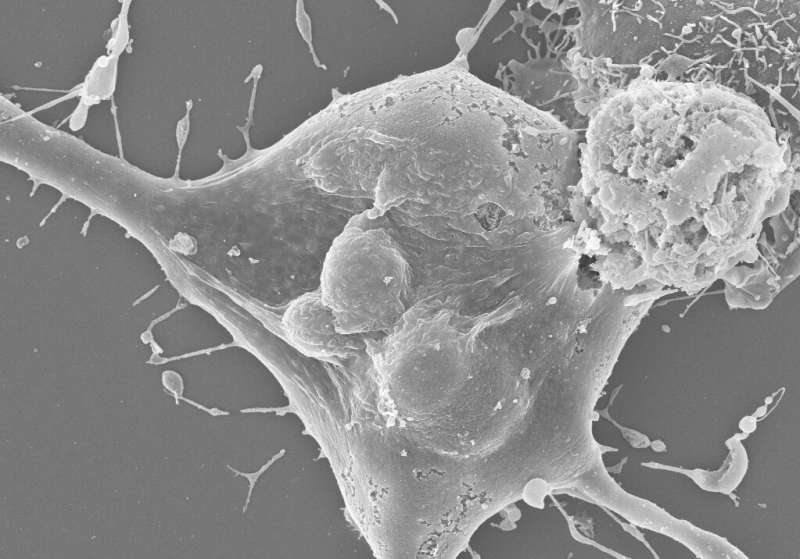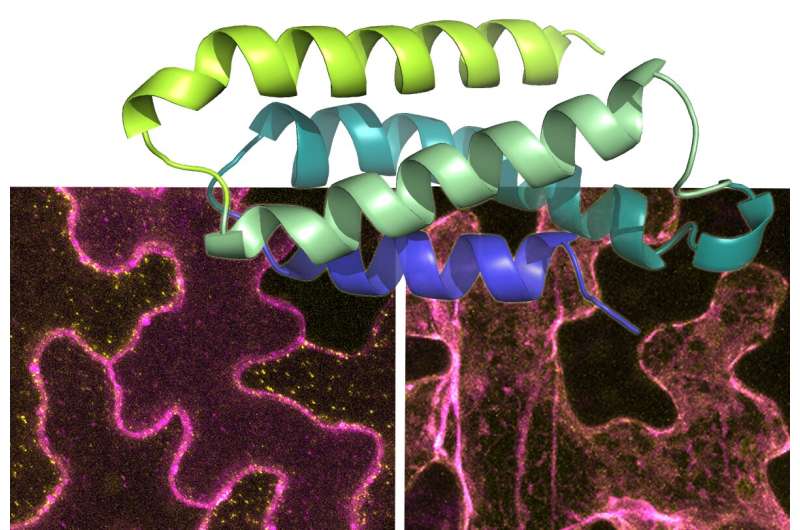Researchers engineered this human cell to express plant defense proteins called NLRs. Though the human cell doesn’t contain any other components of the plant immune system, NLRs alone can still trigger cell death. Credit: Pierre Jacob
Plant cells self-destruct to survive. After detecting a pathogen, they set off a chain reaction that ultimately destroys them, preventing disease from spreading.
Now, scientists have discovered the mechanism behind this self-destruction. Plant defense proteins cluster together to pierce the cell membrane, opening a channel into the infected cell. Calcium then floods in, ultimately killing the cell, Howard Hughes Medical Institute Investigator Jeffery Dangl and his team report June 17, 2021, in the journal Science.
Scientists have long known such pathogen-induced cell death occurs in plants. And the defense proteins were first identified in the mid 1990s. "But nobody knew how they worked to control cell death and immune responses," says Dangl, a plant biologist at the University of North Carolina at Chapel Hill. "Now, we know they all work through a never-before-seen kind of channel."
The findings align with a recent study in Cell, which reported a similar result in a different category of plant immune proteins. Because this family of proteins is found in most land plants, the mechanism probably holds true across the plant kingdom, Dangl suggests.
"This is a profoundly important advance," says Jonathan Jones, a plant immunologist at The Sainsbury Laboratory in Norwich, England, who wasn't involved in the work. "We get two parallel stories with complementary results that show the same thing."
Activated plant immune proteins (pink) move to the cell membrane (left panel). When inactive, these proteins spread throughout the cell (right). The overlay (green and blue ribbons) shows the protein structure that pierces the cell membrane to form a channel. Credit: Dr. Farid El Kasmi
The proteins Dangl's team studied, called NLRs, detect specific pathogen molecules. Most plants carry genes for hundreds of NLRs. A few years ago, Dangl came across a paper reporting an interesting phenomenon in one kind of these proteins. They clumped together and moved towards the cell membrane—a behavior often seen in proteins that make membrane channels. Dangl and his team wondered whether something similar might occur with the NLR proteins his lab studied, and whether it could be related to the cell death pathway.
The researchers used a technique called X-ray crystallography to take detailed pictures of this NLR protein's structure. Then, they made targeted mutations to the protein, to see how changes in various places affected its function.
By testing how different versions of the protein behaved in cells and in lab dishes, the researchers pieced together a picture of its mode of action. That picture looks something like this: In the presence of a pathogen, NLR proteins merge into a mega-protein. Then, part of the protein forms a funnel-like structure that pokes into the membrane of an infected cell. That creates a channel that lets calcium into the cell. Because high levels of calcium are toxic, an influx can mean death for the cell.
In another experiment, the team engineered human cells to contain an NLR protein. Human cells don't have any other parts of the plant immune system. But just having an active NLR protein was enough to let calcium in and kill the cells, the researchers showed. That suggests the protein is the driving force behind the calcium surge.
Next, the team is exploring whether calcium kills the plant cells directly, or whether it turns on other defense pathways that lead to cell death. Hammering out these pathways gives scientists a better understanding of how plants protect themselves, Dangl says, and that could help improve the design of disease-resistant crops.
More information: Pierre Jacob et al, Plant "helper" immune receptors are Ca2+-permeable nonselective cation channels, Science (2021). DOI: 10.1126/science.abg7917
Journal information: Science
Provided by Howard Hughes Medical Institute

























